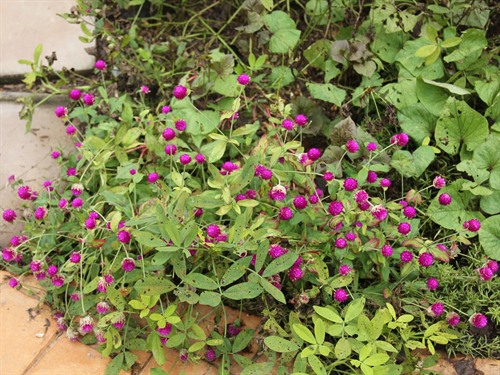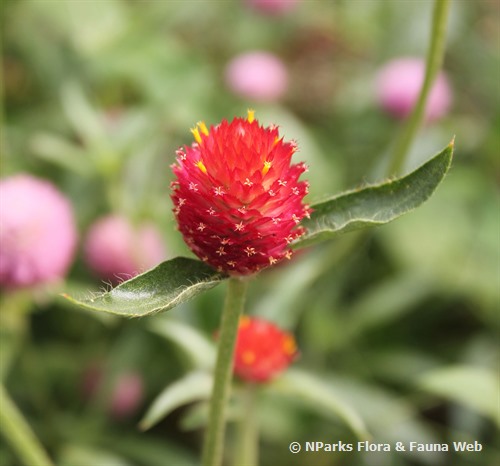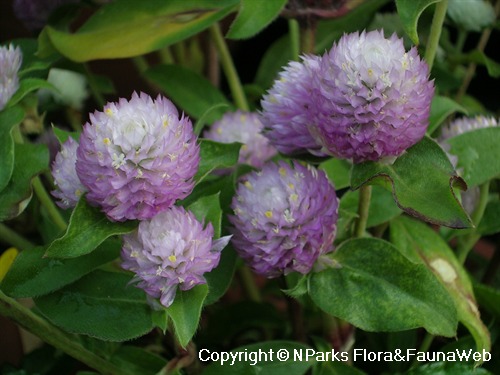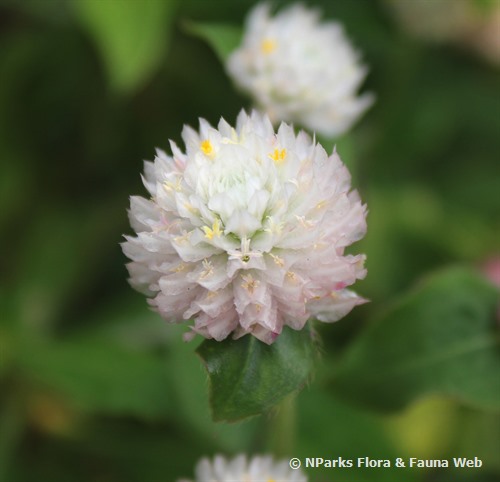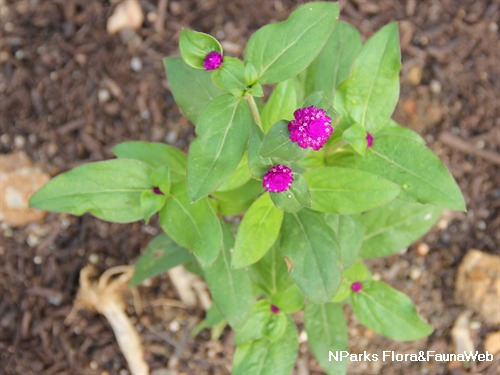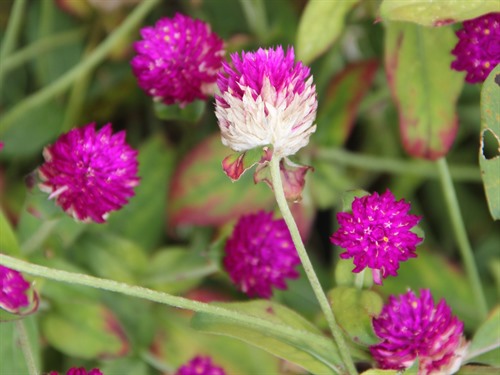
Name
Classifications and Characteristics
| Plant Division | Angiosperms (Flowering Seed Plants) |
|---|---|
| Plant Growth Form | Herbaceous Plant |
| Lifespan (in Singapore) | Annual |
| Mode of Nutrition | Autotrophic |
| Plant Shape | Rounded |
| Maximum Height | 0.5 m |
| Maximum Plant Spread / Crown Width | 0.3 m |
Description and Ethnobotany
| Growth Form | Annual herb with low, upright growth habit up to 45 cm. |
|---|---|
| Foliage | Greyish green, lanceolate leaves have a velvet-like texture (about 5 cm long). |
| Stems | The round stem is densely covered in short hairs. |
| Flowers | The true flowers are tiny, white to yellow, tubular flowers embedded within a globose to egg-shaped head of magenta to purple bracts. The flowers have narrow triangular lobes which form a star-shaped pattern. The arrangement of flowers is known as a dichasial cyme. |
| Fruit | The light brown fruit is dry, indehiscent and shaped like a banjo. It contains a single yellow-brown, round seed. |
| Cultivation | This cultivar is easy-to-grow and heat/ drought tolerant. Avoid overwatering, but provide regular watering and allow the soil to dry before re-watering. Space plants about 30-45 cm apart. Pinch the stem tips of young plants to encourage branching and bushiness (ie., pluck the stem tip off just above a pair of leaves). |
| Ethnobotanical Uses | Food (Herb or Spice): The dried flowers can be used to make herbal tea. Cut - Dried Flower: The flowers are often used to make traditional Hawaiian leis. For dried flower arrangements, harvest the blooms before they are fully open. |
Landscaping Features
| Desirable Plant Features | Ornamental Flowers |
|---|---|
| Landscape Uses | Small Gardens, Flowerbed / Border |
Fauna, Pollination and Dispersal
| Fauna Pollination Dispersal Associated Fauna | Butterfly-Attracting (Flower Nectar) |
|---|---|
| Pollination Method(s) | Biotic (Fauna) (Insects (Butterfly, Moth), Insects (Bee)) |
Plant Care and Propagation
| Light Preference | Full Sun |
|---|---|
| Water Preference | Moderate Water |
| Rootzone Tolerance | Drought Tolerant, Poor Infertile Soils, Easy to Grow |
Foliar
| Foliage Retention | Evergreen |
|---|---|
| Mature Foliage Colour(s) | Green |
| Mature Foliage Texture(s) | Velvety / Furry / Tomentose |
| Foliar Modification | Flower/Fruit Bract |
| Foliar Type | Simple / Unifoliate |
| Foliar Arrangement Along Stem | Opposite |
| Foliar Attachment to Stem | Sessile |
| Foliar Shape(s) | Non-Palm Foliage (Elliptical, Oblong) |
| Foliar Venation | Pinnate / Net |
| Foliar Margin | Entire, Ciliate / Hairy |
| Foliar Apex - Tip | Acute |
| Foliar Base | Rounded / Obtuse, Attenuate |
| Typical Foliar Area | Microphyll ( 2.25cm2 - 20.25 cm2 ), Notophyll ( 20.25cm2 - 45 cm2 ) |
Floral (Angiosperm)
| Flower & Plant Sexuality | Bisexual Flowers |
| Flower Colour(s) | Purple |
|---|---|
| Flower Texture(s) | Papery |
| Flower Grouping | Cluster / Inflorescence |
| Flower Location | Terminal |
| Flower Symmetry | Radial |
| Individual Flower Shape | Tubular |
| Flower Lifespan on Plant | Several Days |
| Flower Colour(s) Remarks | The true flowers are white or yellow, but often overlooked because they are small and inconspicuous. |
Fruit, Seed and Spore
| Mature Fruit Colour(s) | Brown |
|---|---|
| Mature Fruit Texture(s) | Papery |
| Fruit Classification | Simple Fruit |
| Fruit Type |
Image Repository
Others
| Master ID | 32756 |
|---|---|
| Species ID | 7168 |
| Flora Disclaimer | The information in this website has been compiled from reliable sources, such as reference works on medicinal plants. It is not a substitute for medical advice or treatment and NParks does not purport to provide any medical advice. Readers should always consult his/her physician before using or consuming a plant for medicinal purposes. |


